|
|
“Give a Day, Get a Disney Day” March 12, 2010 |
||
|
|
|||
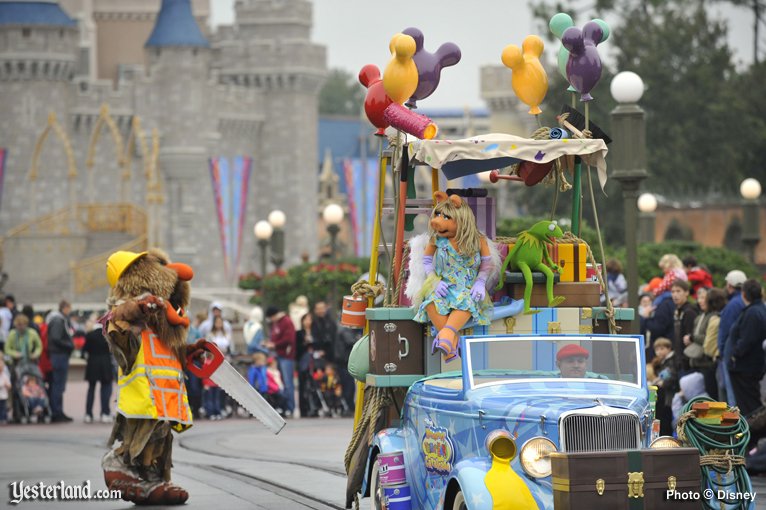 Disney’s publicity for “Give a Day, Get a Disney Day” used the Muppets. |
|||
|
Disney’s big marketing campaign for 2010 was “Give a Day, Get a Disney Day,” an opportunity to earn Disney theme park tickets by doing local volunteer work in the United States and Canada. The evening of March 9, just 68 days into 2010, Disney announced that the program was over. “Give a Day, Get a Disney Day” has “gone to Yesterland.” My wife and I each earned free ticket vouchers last month. Our two kids, who are in college, managed to get into the system just under the wire—one was officially listed as “signed up for an upcoming activity” on March 8 and the other on the morning of March 9.
|
|||
|
|
|||
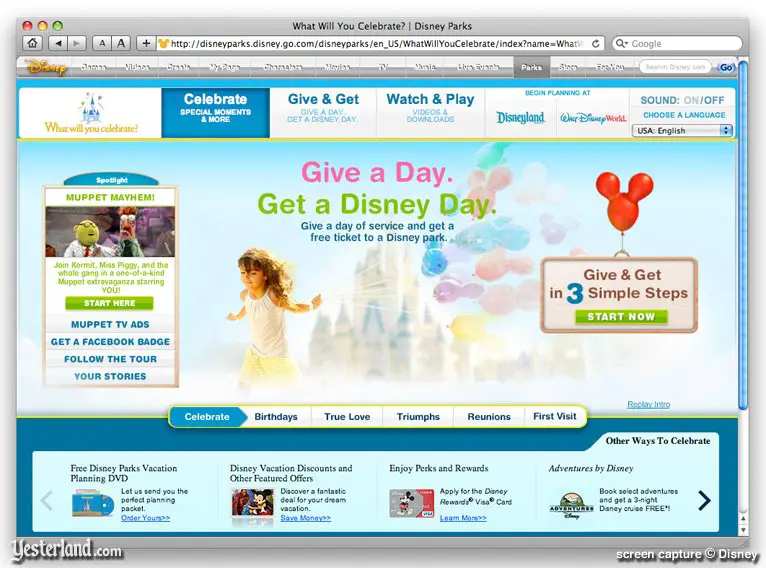 February 1, 2010: Starting the sign-up process |
|||
|
It was February 1, 2010. I was making plans for an early-March Florida vacation that would include a week in Orlando. I thought it might be fun to spend a day at the Epcot Flower & Garden Festival, but our Walt Disney World annual passes expired in October 2009. I couldn’t justify the cost of Disney tickets. If we waited until November 2010 to buy new annual passes, we would get a lot more use from them during the following 12 months. One-day, one-park tickets, at around $84 each including tax, plus $14 for parking, would set us back $182 (ouch!). We didn’t want multi-day tickets either. I had the perfect answer! We would volunteer through Disney’s “Give a Day, Get a Disney Day” promotion to earn free park admission tickets. We would do well by doing good. |
|||
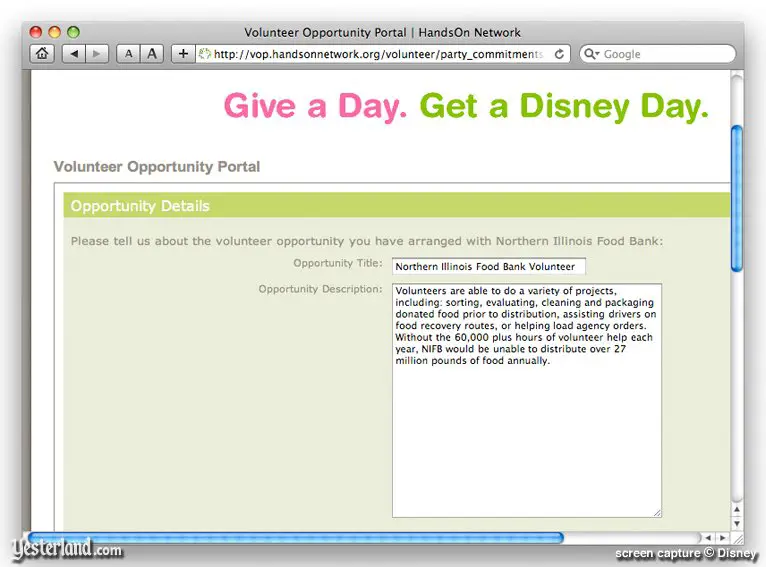 February 2, 2010: Entering information about the volunteer opportunity |
|||
|
I went to the official Disney Parks website to begin the process. It turned out to be fairly complicated—not because they made it needlessly complex, but because of the nature of choosing, confirming, completing, and verifying volunteer shifts. In the United States, HandsOn Network manages the volunteer opportunities, so much of the process involves their website, not Disney’s. My first surprise was that I couldn’t register until I had been scheduled and confirmed for a volunteer shift. So I put in my zip code to search for opportunities near me. My next surprise was how few opportunities came up within a 20-mile radius—especially considering the population of the Chicago metropolitan area where we live. Then I noticed a small text link offering additional volunteer opportunities. Suddenly, far more organizations came up, but usually without any details about what a volunteer might do for them. Eventually, I stumbled onto a listing for the Northern Illinois Food Bank. I know they do a terrific job in the fight against hunger, and I’ve made cash contributions to them in the past. Also, I assumed that they could use untrained volunteers. (In comparison, my younger daughter has been going to a series of weekly evening classes before she can work her first volunteer shift at a museum.) |
|||
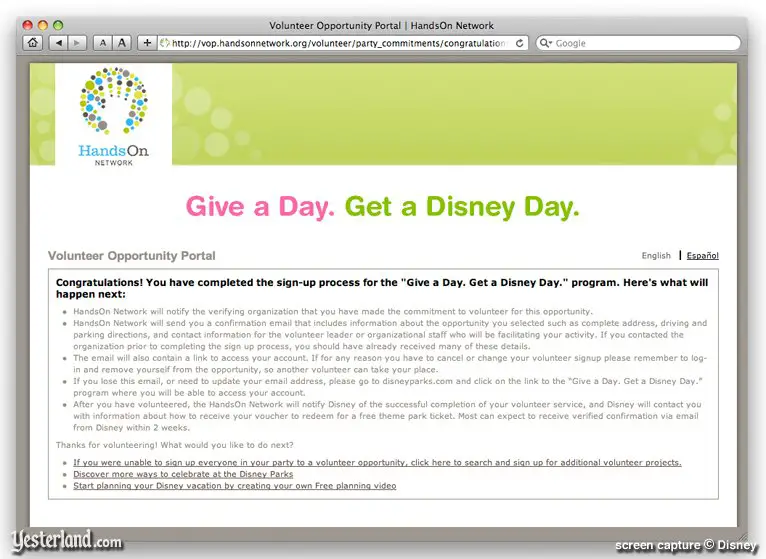 February 2, 2010: Learning what the next steps are after successfully signing up for a volunteer shift |
|||
|
I selected the Northern Illinois Food Bank on the HandsOn Network website. That led to automated reply e-mail, followed by an exchange of e-mail notes with volunteer coordinator Rachael at the Northern Illinois Food Bank. By the next day, my wife and I were scheduled for a shift one week later and I was able to officially register for “Give a Day, Get a Disney Day,” |
|||
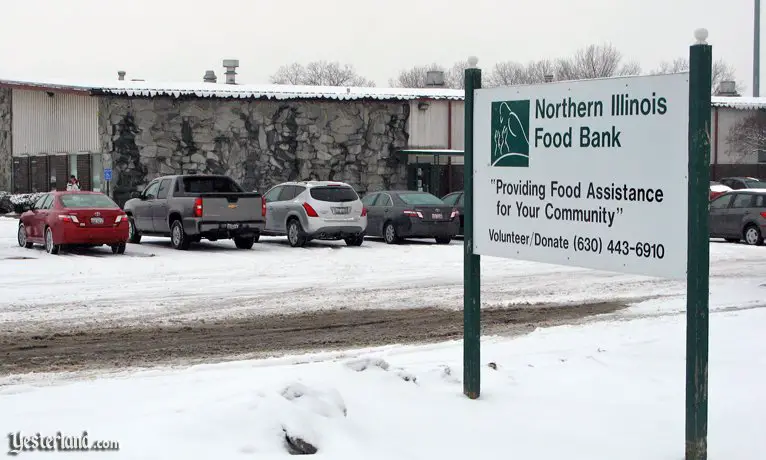 February 9, 2010: Arriving at Northern Illinois Food Bank in St. Charles, Illinois |
|||
|
When I scheduled our shift, I didn’t know that I had picked a day when the Chicago area would be hit by one of the biggest snowstorms of this winter. My wife and I went anyway. On arrival, we were greeted by Rachael. She told us about the Northern Illinois Food Bank and how they collect food from many sources and distribute it to food pantries, shelters, soup kitchens, and other feeding sites in 13 counties of Northeastern Illinois (not including Cook County, where the city of Chicago is located). They rely on around 60,000 hours of volunteer help each year to distribute over 27 million pounds of food annually. That number is going up because so many people have been hit by the weak economy. We also learned that a family of six had volunteered for that day through the Disney program, but had rescheduled due to the weather. |
|||
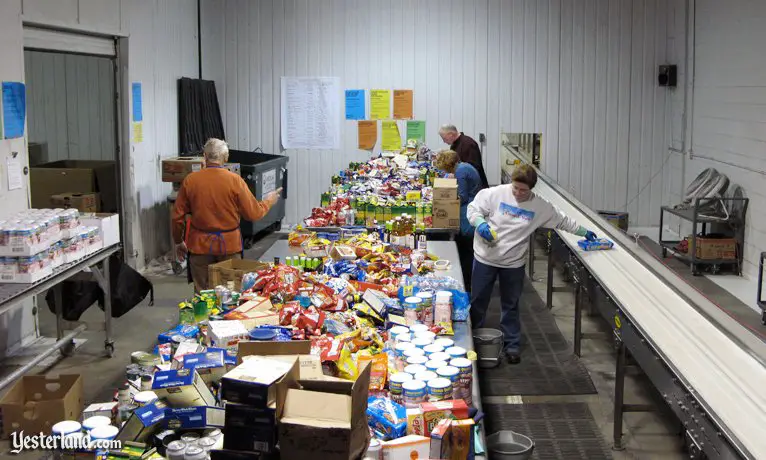 February 9, 2010: Processing donated food at the Northern Illinois Food Bank |
|||
|
My wife and I were assigned to a room where volunteers inspect donated food packages, clean them with a mild bleach solution, and put them onto a conveyor belt to another room where they are boxed for distribution. We worked with other volunteers who show up every week. They were nice people who don’t expect anything in return for their services. In comparison, I felt a little bad that I would be there for only one shift, but I would be paid by Disney in the form of a park admission ticket. At one point, another man and I were pulled to unload a bread truck and to load the trays of bread onto wooden pallets. The work reminded me of my years with the old Alpha Beta grocery chain while going to college. The bread was at its sell-by date but was still perfectly good. I managed to seriously damage one of my shoes (but fortunately not my foot) with the metal hand truck. I was wearing almost new walking shoes with high-traction soles because I didn’t know where I would be assigned, and I didn’t want to slip on an icy surface that day. The shoes were worth more than a Disney admission ticket. Oh, well. That’s part of volunteering too. |
|||
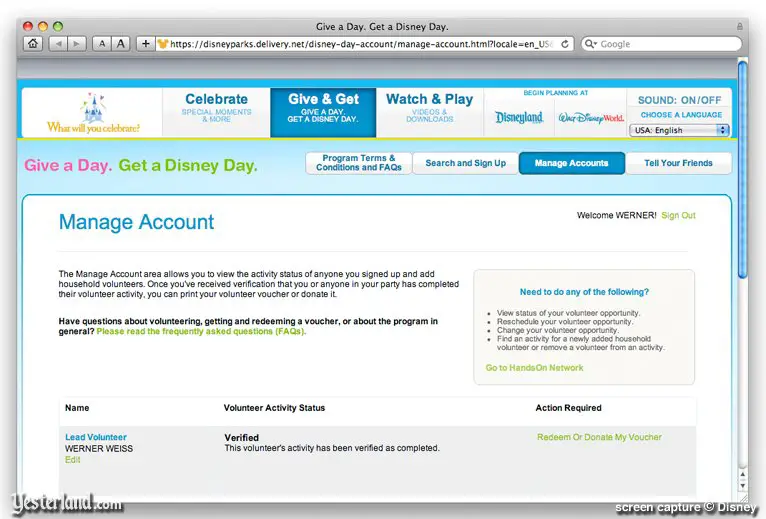 February 14, 2010: It’s official! We earned the vouchers. |
|||
|
Disney says to expect an e-mail up to two weeks after completing the volunteer service. In our case, it only took five days. I guess the Northern Illinois Food Bank is as efficient in reporting back to HandsOn Network as they are in distributing food. |
|||
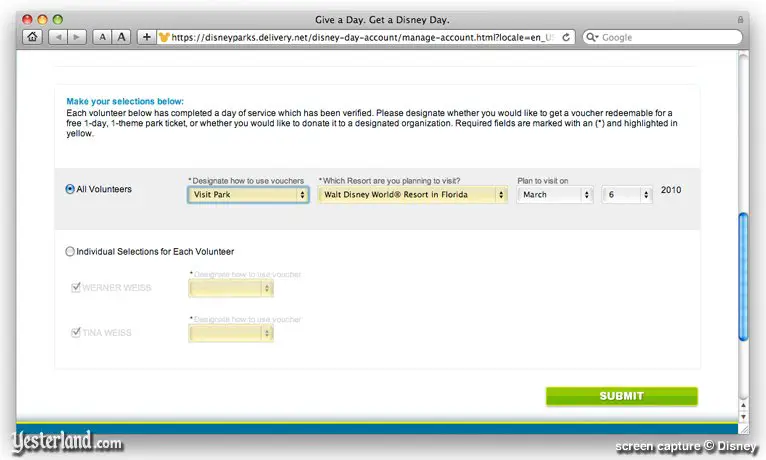 February 14, 2010: Specifying how, where, and when we’ll use the vouchers. |
|||
|
The next step was to specify whether my wife and I wanted park admissions, FASTPASS cards, or collectables. I could also have donated our admission tickets to Boys & Girls Club. Next, I had to specify Walt Disney World or the Disneyland Resort. Finally—and this surprised me—I had to specify a date. Would the vouchers then only be accepted on one specific date? What if we wanted to juggle our schedule for the week based on rain forecasts? When I printed the vouchers I saw that they were not limited to the day I specified. They’re good until December 15, 2010, except on published black-out dates. |
|||
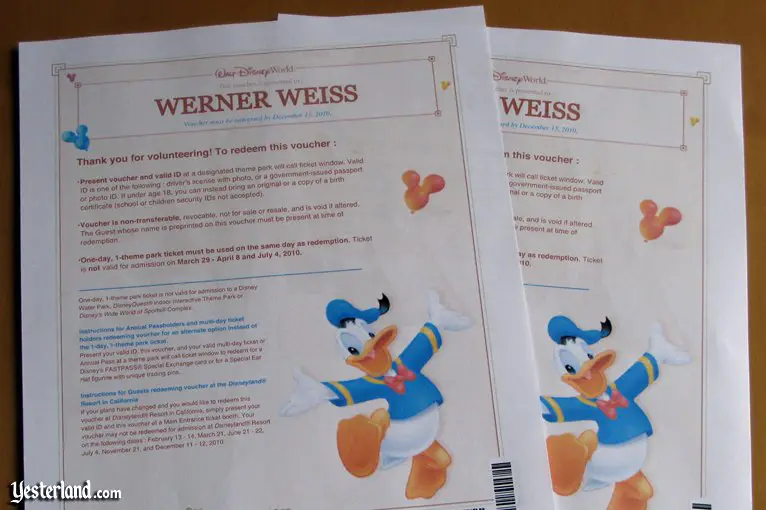 Two vouchers, ready to take to use for admission to a Walt Disney World theme park |
|||
|
This story was supposed to end with a few photos from Epcot. But we never went there. I still have the vouchers. As our Epcot day approached, I remembered reading that the value of vouchers can be applied to multi-day tickets and annual passes. If we would be buying annual passes in November anyway, why not use the vouchers to save $84 on each one? It’s not as if we’ve never been to Epcot. I spoke to Guest Services at Downtown Disney. I learned that I could not apply the ‘Give a Day, Get a Disney Day’ vouchers to annual pass vouchers for future activation. Using a voucher means it becomes active that day, so if its value is applied toward an annual pass, it too would be active that day. However, if I hold onto our vouchers until we return in November, I’ll be able to apply them toward annual passes, which would be effective immediately. By November, annual passes will probably cost somewhat more than now, but the value of a one-day, one-park ticket might be a little higher too. |
|||
|
|
|||
|
On March 9, 2010, Disney issued a press release. Here’s how it opened: “Give a Day, Get a Disney Day”—a first-of-its-kind program of Disney Parks—reached its goal of inspiring 1 million people in 2010 to give back to their communities through volunteer service in the United States, Puerto Rico and Canada. Since the program started just 10 weeks ago, on Jan. 1, a million people already have volunteered or have committed to volunteer in their communities, according to Disney Parks and HandsOn Network, the nation’s largest volunteer network and a facilitator of “Give a Day, Get a Disney Day.” The press release went on to explain that registration had closed and the program had ended. Volunteers who already earned their vouchers but who have not yet used them (like me) are safe. And volunteers with an upcoming activity committed through Disney’s process and officially in the HandsOn Network system (like my kids) are safe too, as long as they work their shift. But anyone else who hoped to earn a free Disney theme park ticket under this promotion is out of luck. |
|||
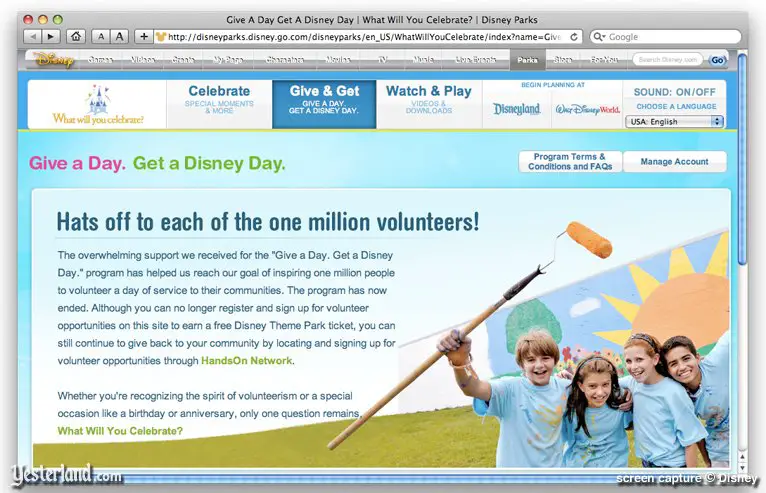 March 9, 2010: “Give a Day, Get a Disney Day” reached the maximum. |
|||
|
Disney didn’t expect to reach 1 million volunteers in just 10 weeks. Possibly, Disney assumed that the requirement to do volunteer work would discourage many people. But Disney underestimated both the willingness of people to do volunteer work and the attractiveness of getting something of value without having to spend money. Disney’s press release quoted Tom Staggs, chairman of Walt Disney Parks and Resorts: “By any measure, the ‘Give a Day, Get a Disney Day’ program exceeded our expectations. These one million volunteers touched their communities with their hearts and hands. Their commitment to service is truly worth celebrating, and there’s no better place to celebrate than at Disney Parks.” Disney could have chosen to increase the number to 2 million or 5 million or 10 million. But Disney is a business, and too many free passes would mean too much lost revenue. The birthday promotion in 2009 encouraged families to visit, with one member of the family getting in free and the rest having to buy expensive one-day tickets. With the volunteer promotion in 2010, an entire family could enter a Disney theme park for free on any day (except for a handful of blackout days), as long as everyone worked a qualifying volunteer shift (admittedly easier for a family with teens or college-age kids than one with children who are too young to volunteer). The typical American (and presumably the typical Canadian) TV viewer was hit with a barrage of 30-second “Give a Day, Get a Disney Day” TV spots, starring the Muppets, that began toward the end of 2009. The key message was, “Beginning in January, give a day of service to a participating organization, and get a one-day ticket to one of our parks, free!” TV viewers were told to visit DisneyParks.com for details. If they followed up, they would learn that Disney hoped to inspire 1 million volunteers in 2010. There was no promise that the program would run through all of 2010. But there was no sense of urgency either. Disney’s limit of 1 million volunteers was part of the program from day one. When the program was first announced, the Disney Parks Blog published: “With this announcement, we’re looking for 1 million people with a passion to make a difference.” Disney did exactly what they promised. They “inspired” a million volunteers, and then the program ended. “Give a Day, Get a Disney Day” can be called a great success because so many Americans and Canadians signed up so quickly. I applaud the million volunteers. And I applaud Disney for focussing attention on volunteerism and for being generous with park admission tickets (and alternate rewards for guests using multi-day and annual passes) to encourage volunteer service. What’s ironic about this “great success” is that Disney found itself without the centerpiece of its 2010 marketing campaign just 68 days into the year. Potential participants who were “inspired” by Disney’s TV ads would now be told “no.” Non-profit organizations that hoped to run events in the spring and summer would be told “no.” (They could still run the events, of course, but they would no longer be able to offer the Disney incentive.) Not quite the goodwill that Disney had hoped to achieve. In an odd way, the program would have generated more goodwill and been better for Disney if it had not been quite such a “great success.” If Disney had known how the program would play out, it’s likely they would have structured it differently. |
|||
© 2010 Werner Weiss — Disclaimers, Copyright, and Trademarks Updated May 11, 2010.
Publicity photo with Muppets: Copyright Disney. |
|||